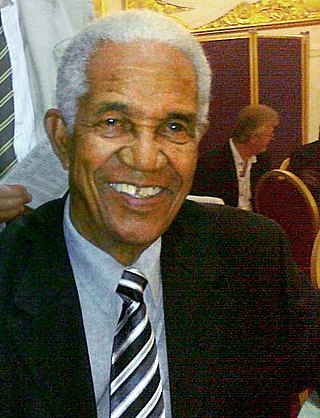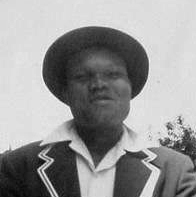Related Research Articles

Sir Garfield St Aubrun Sobers, AO, OCC, also known as Sir Gary or Sir Garry Sobers, is a former cricketer who played for the West Indies between 1954 and 1974. A highly skilled bowler, an aggressive batsman and an excellent fielder, he is widely considered to be cricket's greatest ever all-rounder and one of the greatest cricketers of all time.

Sir Clyde Leopold Walcott KA, GCM, OBE was a West Indian cricketer. Walcott was a member of the "three W's", the other two being Everton Weekes and Frank Worrell: all were very successful batsmen from Barbados, born within a short distance of each other in Bridgetown, Barbados in a period of 18 months from August 1924 to January 1926; all made their Test cricket debut against England in 1948. In the mid-1950s, Walcott was arguably the best batsman in the world. In later life, he had an active career as a cricket administrator, and was the first non-English and non-white chairman of the International Cricket Council.
Sir Wesley Winfield Hall is a Barbadian former cricketer and politician. A tall, strong and powerfully built man, Hall was a genuine fast bowler and despite his very long run up, he was renowned for his ability to bowl long spells. Hall played 48 Test matches for the West Indies from 1958 to 1969. Hall's opening bowling partnership with fellow Barbadian Charlie Griffith was a feature of the strong West Indies teams throughout the 1960s. Hall was one of the most popular cricketers of his day and was especially popular in Australia, where he played two seasons in the Sheffield Shield with Queensland.

Sir Everton DeCourcy Weekes, KCMG, GCM, OBE was a cricketer from Barbados. A right-handed batsman, he was known as one of the hardest hitters in world cricket. Weekes holds the record for the most consecutive Test hundreds, with five. Along with Frank Worrell and Clyde Walcott, he formed what was known as "The Three Ws" of the West Indies cricket team. Weekes played in 48 Test matches for the West Indies cricket team from 1948 to 1958. He continued to play first-class cricket until 1964, surpassing 12,000 first-class runs in his final innings. As a coach he was in charge of the Canadian team at the 1979 Cricket World Cup, and he was also a commentator and international match referee.

Sir Conrad Cleophas Hunte, KA was a Barbadian cricketer. Hunte played 44 Test matches as an opening batsman for the West Indies.

Clifford Archibald Roach was a West Indian cricketer who played in West Indies' first Test match in 1928. Two years later, he scored the West Indies' first century in Test matches, followed two matches later by the team's first double century. Roach played for Trinidad, but before having any great success at first-class level, he was chosen to tour England with a West Indies team in 1928 and scored over 1,000 runs. When England played in the West Indies in 1930, he recorded his ground-breaking centuries but had intermittent success at Test level afterwards. He toured Australia in 1930–31 and returned to England in 1933, when he once more passed 1,000 runs, but was dropped from the team in 1935. Within three years, he lost his place in the Trinidad team. Roach was generally inconsistent, but batted in an attacking and attractive style. Outside of cricket, he worked as a solicitor. Later in his life, he suffered from diabetes which necessitated the amputation of both his legs.
Seymour MacDonald Nurse was a Barbadian cricketer. Nurse played 29 Test matches for the West Indies between 1960 and 1969. A powerfully built right-hand batsman and an aggressive, if somewhat impetuous, shotmaker, Nurse preferred to bat in the middle order but was often asked to open the batting. A relative latecomer to high-level cricket, Nurse's Test cricket career came to what many consider a premature end in 1969.
Maurius Pacheco Fernandes, known as Maurice Fernandes, was a West Indian Test cricketer who played first-class cricket for British Guiana between 1922 and 1932. He made two Test appearances for the West Indies, in 1928 and 1930. Fernandes played as a right-handed top-order batsman and occasional wicket-keeper. He scored 2,087 first-class runs in 46 appearances at an average of 28.20.

Wilton H. St Hill was a West Indian international cricketer who played in West Indies' first Test match during their inaugural Test tour of England. A right-handed batman who played in a variety of batting positions, he represented Trinidad in first-class cricket between 1912 and 1930 and played in three Test matches in total. Although his Test record was poor, he was highly regarded in Trinidad. In particular, writer C. L. R. James considered St Hill to be among the top batsmen in the world and dedicated a chapter of Beyond a Boundary to him. At the peak of his career, Lord Harris described him as the best batsman in the West Indies.

Joseph A. Small was a West Indian cricketer who played in West Indies' first Test in their inaugural Test tour of England. He scored the first half century for a West Indies player in Test cricket and played two further Test matches in his career. An all-rounder, he played domestic cricket for Trinidad between 1909 and 1932.

Emmanuel Alfred Martindale was a West Indian cricketer who played in ten Test matches from 1933 to 1939. He was a right-arm fast bowler with a long run up; although not tall for a bowler of his type he bowled at a fast pace. With Learie Constantine, Martindale was one of the earliest in the long succession of Test-playing West Indian fast bowlers. During the time he played, the West Indies bowling attack depended largely on his success. Critics believe that his record and performances stand comparison with bowlers of greater reputation and longer careers.

Wilfred Ferguson was a West Indian cricketer who played in eight Tests from 1947-48 to 1953–54. He played first-class cricket for Trinidad from 1943 to 1956.
George Leslie Wight was a West Indian international cricketer who played in one Test match in 1953.
The English cricket team in the West Indies in 1953–54 played five Test matches, five other first-class matches and seven other games, three of them on a two-week stop-over in Bermuda that included Christmas.
The English cricket team in the West Indies in 1934–35 was a cricket touring party sent to the West Indies under the auspices of the Marylebone Cricket Club for a tour lasting 2+1⁄2 months in 1934–35. The team played four Test matches against the West Indian cricket team, winning one match but losing two – the first series defeat of an English side by the West Indies.
The English cricket team in the West Indies in 1959–60 played five Test matches, eight other first-class matches and two minor games. England won the Test series by one match to nil, with the other four matches being drawn.
The West Indies cricket team toured Australia in the 1960–61 season under the captaincy of Frank Worrell. Both Worrell and his opposing captain, Richie Benaud, encouraged their teams to play attacking cricket. The first Test of the five match series ended in a dramatic tie, the first of only two instances in Test cricket. Though West Indies narrowly lost the series 2–1, with one draw in addition to the tie, they might easily have won both the last two matches and taken the series 3–1. They took much credit for contributing to such an exciting series and made themselves extremely popular with the Australian public. Prior to their departure from Australia, the team were paraded through Melbourne in open-top cars on 17 February 1961, and were cheered by enormous crowds.
This article describes the history of West Indies cricket from 1946 to 1970.
This article describes the history of West Indies cricket from 1991 to 2000.

George Alphonso Headley OD, MBE was a West Indian cricketer who played 22 Test matches, mostly before World War II. Considered one of the best batsmen to play for the West Indies and one of the greatest cricketers of all time, Headley also represented Jamaica and played professional club cricket in England. West Indies had a weak cricket team through most of Headley's playing career; as their one world-class player, he carried a heavy responsibility and the side depended on his batting. He batted at number three, scoring 2,190 runs in Tests at an average of 60.83, and 9,921 runs in all first-class matches at an average of 69.86. He was chosen as one of the Wisden Cricketers of the Year in 1934.
References
- ↑ British Guiana v Barbados 1951-52
- ↑ Barbados v Jamaica 1951-52
- ↑ Jamaica v Barbados 1958
- ↑ Wisden 1962, p. 848.
- ↑ Wisden 1962, p. 852.
- ↑ West Indies v India, Port of Spain 1961-62
- ↑ Barbados v Trinidad 1962-63
- ↑ Tony Cozier, The West Indies: Fifty Years of Test Cricket, Angus & Robertson, Brighton (UK), 1978, p. 102.